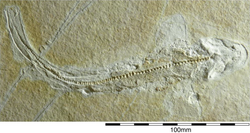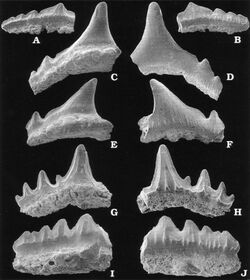Biology:Synechodontiformes
| Synechodontiformes | |
|---|---|

| |
| Fossil of Synechodus ungeri from the Late Jurassic of Germany | |

| |
| Fossil teeth of Palidiplospinax occultidens (top) and P. enniskilleni | |
| Scientific classification | |
| Domain: | Eukaryota |
| Kingdom: | Animalia |
| Phylum: | Chordata |
| Class: | Chondrichthyes |
| Subclass: | Elasmobranchii |
| Clade: | Neoselachii |
| Order: | †Synechodontiformes Duffin & Ward, 1993[2] |
| Families | |
|
See text | |
Synechodontiformes is an extinct order of prehistoric shark-like cartilaginous fish, known from the Permian to the Paleogene. They are considered to be members of Neoselachii, the group that contains modern sharks and rays.
Their placement in the group is uncertain, some authors have considered them to be members of the modern shark group Galeomorphii, while others have considered them to represent a stem-group to modern sharks,[3][4] with some suggesting that they are basal to the last common ancestor of modern sharks and rays.[5] There is also disagreement about the relationships between Triassic and earlier members of the group, only known from isolated teeth, and those from the Jurassic onwards, with the similarity between the two groups possibly being superficial.[6]
While Klug (2010) recovered the group as monophyletic,[4] the monophyly of the group has been doubted by other authors, who suggest that they represent a paraphyletic group.[5] The families Orthacodontidae, Paraorthacodontidae and Pseudonotidanidae have been alternatively considered as members of modern shark order Hexanchiformes rather than as members of Synechodontiformes.[7]
The oldest known synechodontiform remains are teeth of Synechodus antiquus from the early Permian (Cisuralian) of the Ural Mountains.[8] However, other authors have considered the attribution to the teeth to Synechodus to be questionable.[6]
Taxonomy
Based on the Shark-References database:[7]
- †Palaeospinacidae (Regan, 1906).
- †Antrigoulia (Guinot, Cappetta, & Adnet, 2014). Southern France, Early Cretaceous (Valanginian).[9]
- †Palidiplospinax (Klug & Kriwet, 2008). Western England and southern Wales, Late Triassic to Early Jurassic (Rhaetian to Sinemurian, 201-198 Ma).
- †Palaeospinax (Egerton, 1872)[7] (nomen dubium[10])
- †Synechodus (Woodward, 1888) Worldwide distribution, Permian to Eocene.[11]
- Incertae sedis
Disputed members
These members were classified in the Synechodontiformes by Klug (2010), but are classified other authors as Hexanchiformes:[7][14]
- †Orthacodontidae de Beaumont, 1960
- †Occitanodus (Guinot, Cappetta & Adnet, 2014). France, Early Cretaceous (Valanginian).[9]
- †Sphenodus (Agassiz, 1843). Early Jurassic to Paleocene.[15]
- †Paraorthacodontidae (Klug, 2010)
- †Macrourogaleus (Fowler, 1947). Southeastern Germany, Late Jurassic (Tithonian, 152-145 Ma).
- †Paraorthacodus (Glikman, 1957) Worldwide, Early Jurassic-Eocene
- †Pseudonotidanidae Underwood and Ward 2004
- Incertae sedis
- †Rhomphaiodon (Duffin, 1993a). Britain, France, Belgium, Luxembourg, and Germany, Late Triassic to Early Jurassic (Norian to Toarcian, 215-175 Ma).
References
- ↑ "†order Synechodontiformes Duffin and Ward 1993 (elasmobranch)". http://www.fossilworks.org/cgi-bin/bridge.pl?a=taxonInfo&taxon_no=100266.
- ↑ C. J. Duffin and D. J. Ward. 1993. The Early Jurassic Palaeospinacid sharks of Lyme Regis, southern England. Belgian Geological Survey, Professional Papers, Elasmobranches et Stratigraphie 264:53-102
- ↑ Bazzi, Mohamad; Campione, Nicolás E.; Ahlberg, Per E.; Blom, Henning; Kear, Benjamin P. (2021-08-10). Quental, Tiago Bosisio. ed. "Tooth morphology elucidates shark evolution across the end-Cretaceous mass extinction" (in en). PLOS Biology 19 (8): e3001108. doi:10.1371/journal.pbio.3001108. ISSN 1545-7885. PMID 34375335.
- ↑ 4.0 4.1 Klug, Stefanie (2010). "Monophyly, phylogeny and systematic position of the †Synechodontiformes (Chondrichthyes, Neoselachii)" (in en). Zoologica Scripta 39 (1): 37–49. doi:10.1111/j.1463-6409.2009.00399.x. ISSN 1463-6409. https://onlinelibrary.wiley.com/doi/abs/10.1111/j.1463-6409.2009.00399.x.
- ↑ 5.0 5.1 Maisey, J. G. (April 2012). "What is an ‘elasmobranch’? The impact of palaeontology in understanding elasmobranch phylogeny and evolution" (in en). Journal of Fish Biology 80 (5): 918–951. doi:10.1111/j.1095-8649.2012.03245.x. ISSN 0022-1112. https://onlinelibrary.wiley.com/doi/10.1111/j.1095-8649.2012.03245.x.
- ↑ 6.0 6.1 Rees, Jan; Campbell, Hamish J.; Simes, John E. (2023-05-21). "The first Triassic elasmobranch teeth from the Southern Hemisphere (Canterbury, New Zealand)" (in en). New Zealand Journal of Geology and Geophysics: 1–8. doi:10.1080/00288306.2023.2214369. ISSN 0028-8306. https://www.tandfonline.com/doi/full/10.1080/00288306.2023.2214369.
- ↑ 7.0 7.1 7.2 7.3 "Bibliography Database | Shark-References". https://shark-references.com/.
- ↑ Ivanov, Alexander (2005-08-30). "Early Permian chondrichthyans of the Middle and South Urals". Revista Brasileira de Paleontologia 8 (2): 127–138. doi:10.4072/rbp.2005.2.05. http://www.sbpbrasil.org/revista/edicoes/8_2/8(2)ivanov.pdf.
- ↑ 9.0 9.1 Guinot, Guillaume; Cappetta, Henri; Adnet, Sylvain (March 2014). "A rare elasmobranch assemblage from the Valanginian (Lower Cretaceous) of southern France" (in en). Cretaceous Research 48: 54–84. doi:10.1016/j.cretres.2013.11.014. Bibcode: 2014CrRes..48...54G. https://linkinghub.elsevier.com/retrieve/pii/S0195667113001869.
- ↑ Klug, Stefanie; Kriwet, Jürgen (May 2008). "A new basal galeomorph shark (Synechodontiformes, Neoselachii) from the Early Jurassic of Europe" (in en). Naturwissenschaften 95 (5): 443–448. doi:10.1007/s00114-007-0341-0. ISSN 0028-1042. http://link.springer.com/10.1007/s00114-007-0341-0.
- ↑ Batchelor, Trevor J.; Duffin, Christopher J. (August 2020). "First description of sharks' teeth from the Ferruginous Sands Formation (Aptian, Early Cretaceous) of the Isle of Wight" (in en). Proceedings of the Geologists' Association 131 (3–4): 353–359. doi:10.1016/j.pgeola.2019.06.004. Bibcode: 2020PrGA..131..353B. https://linkinghub.elsevier.com/retrieve/pii/S0016787819300598.
- ↑ https://www.mindat.org/taxon-P162123.html
- ↑ Koot, Martha B.; Cuny, Gilles; Orchard, Michael J.; Richoz, Sylvain; Hart, Malcolm B.; Twitchett, Richard J. (2015-10-03). "New hybodontiform and neoselachian sharks from the Lower Triassic of Oman" (in en). Journal of Systematic Palaeontology 13 (10): 891–917. doi:10.1080/14772019.2014.963179. ISSN 1477-2019. Bibcode: 2015JSPal..13..891K. http://www.tandfonline.com/doi/full/10.1080/14772019.2014.963179.
- ↑ Klug, Stefanie (January 2010). "Monophyly, phylogeny and systematic position of the †Synechodontiformes (Chondrichthyes, Neoselachii)" (in en). Zoologica Scripta 39 (1): 37–49. doi:10.1111/j.1463-6409.2009.00399.x. ISSN 0300-3256. https://onlinelibrary.wiley.com/doi/10.1111/j.1463-6409.2009.00399.x.
- ↑ Kanno, Shiori; Nakajima, Yasuhisa; Hikida, Yoshinori; Sato, Tamaki (2017-04-01). "Sphenodus (Chondrichthyes, Neoselachii) from the Upper Cretaceous in Nakagawa Town, Hokkaido, Japan". Paleontological Research 21 (2): 122. doi:10.2517/2016PR009. ISSN 1342-8144. https://bioone.org/journals/paleontological-research/volume-21/issue-2/2016PR009/Sphenodus-Chondrichthyes-Neoselachii-from-the-Upper-Cretaceous-in-Nakagawa-Town/10.2517/2016PR009.full.
- ↑ 16.0 16.1 Klug, Stefanie; Kriwet, Jürgen (2010-09). "A new Late Jurassic species of the rare synechodontiform shark, Welcommia (Chondrichthyes, Neoselachii)" (in en). Paläontologische Zeitschrift 84 (3): 413–419. doi:10.1007/s12542-010-0058-9. ISSN 0031-0220. http://link.springer.com/10.1007/s12542-010-0058-9.
External links
Wikidata ☰ Q15411625 entry
 |

